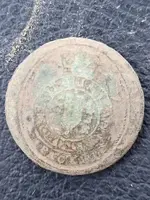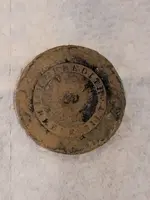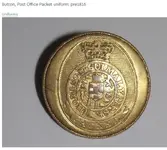OK. I think this is from Melchisedek (Mel) Meredith. He was not a button maker, but a Naval Tailor, and a prestigious one too. Most of the great naval commanders of the period were his clients including Rodney, Hood, Howe, Collingwood and Nelson. He set up business in 1785 at 73 High Street, Portsmouth on the South Coast of England but the button would likely have been made for him in London or Birmingham.
Meredith died in 1814 but, largely due to his relaxed attitude in chasing customers for payment, his 17 year-old son Augustus inherited a business with considerable debts and was compelled to keep it open to try and clear them. Worse still, the Battle of Waterloo in 1815 saw Europe enter a period of peace with a dramatic reduction in the demand for army and navy uniforms. Augustus opened premises in London to try and drum up further business but declared bankruptcy in 1837 and the remaining assets were bought out by Joseph Galt four years later.
So, we can definitely say the button is later George III or George IV (between 1785-1830) or William IV (1830-1837). Given the indented backmark and the nature of the customer, I would put it near the end of Meredith’s period of operation and perhaps during the period when his son was striving to get the business back into profit.
We then come to “packet boats”. These have a long history of operation as an ‘official’ service, dating back to the establishment of the General Post Office in 1660. The postal service was known as the ‘Royal Mail’ because it was built on the distribution system for royal and government documents. Packet boats operated out of a number of ports to particular destinations on regular scheduled services, but with departure and arrival dates somewhat dependent on weather conditions. By the time of your button, the boats were also routinely carrying valuables and passengers. They were fast, medium sized vessels, armed for protection (but lightly so), largely relying on their speed to keep them out of danger.
These boats were not part of the Royal Navy as such, but were privately operated under a Royal Warrant as a government monopoly. From the 18th Century, they also plied across the Atlantic to maintain government contact between Great Britain and its colonies. That situation continued until 1823 when the Admiralty assumed direct control of the services and I believe your button is probably from immediately after that change. The Admiralty began replacing older boats with unsuitable and dilapidated vessels decommissioned at the end of the Napoleonic wars and ultimately with steam vessels rather than sailing ships; but the reliability of the service had already suffered and the government disbanded it in 1850 in favour of fully ‘contracting out’.
 135107470_10220636911927451_2095514086035104937_o.webp358.7 KB · Views: 88
135107470_10220636911927451_2095514086035104937_o.webp358.7 KB · Views: 88 134942159_10220636908447364_5928759283938126910_o.webp209.2 KB · Views: 83
134942159_10220636908447364_5928759283938126910_o.webp209.2 KB · Views: 83 134075080_10220636909807398_1386093107746088865_o.webp200.9 KB · Views: 82
134075080_10220636909807398_1386093107746088865_o.webp200.9 KB · Views: 82 Packet Button.webp58.7 KB · Views: 92
Packet Button.webp58.7 KB · Views: 92 134594829_10220636934728021_5307555517080235786_o.webp218.3 KB · Views: 87
134594829_10220636934728021_5307555517080235786_o.webp218.3 KB · Views: 87



